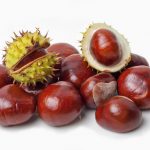The comestible seed, ensconced in a sleek tawny shell surrounded by a thorny husk, emanates from a deciduous tree that is a member of the Fagaceae family, encompassing both the oak and beech species. This seed, also known as a chestnut, can be subjected to various culinary preparations such as roasting, boiling and puréeing, or utilized in dressings, and even made into a sweet confection known in the French language as “marron glacé.” The term “marron” is commonly used in gastronomic contexts to refer to chestnuts.
Chestnuts are the edible fruit of the Spanish or sweet chestnut tree. Once the fruit ripens, the prickly green husks will fall to the ground, revealing the reddish brown nuts inside. These nuts can be roasted in front of a fire or in a chestnut roaster, and served with a pinch of salt as a tasty snack. Alternatively, they can be stewed and served as a vegetable. Chestnuts may also be dried and ground into flour, or cooked, pureed, and used to create various garnishes and desserts.

